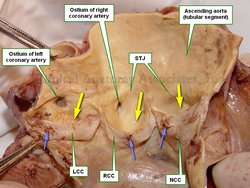The eponymic nodules (or nodes) of Arantius are thickenings of the tunica intima layer covering the ventricular aspect of the leaflets of the aortic valve, also known as the ventricularis layer (see blue arrows in the accompanying image). The thickening happens at the point of coaptation of all three leaflets. The shape and size of these growths varies from person to person and with age. The proper name for these structures is “nodes of the semilunar cusps” or “noduli valvularium semilunarium valvae aortae” in Latin
The portion of the leaflet proximal to the node of Arantius is the load-bearing portion and the portion of the leaflet distal to the node of Arantius is non-functional and is known as the “lunule”
Hypertrophy of the node of Arantius is not common, but when present and excessive it can lead to aortic valve dysfunction and insufficiency.
These excrescences of the valve leaflets are named after Giulio Cesare Aranzio (1530 – 1589), an Italian anatomist better known by his Latinized name Arantius.
Although most anatomists and surgeons use the same eponym for the excrescences of the pulmonary valve, those should be called the “nodes of Morgagni” after Giovanni Batista Morgagni (1682 - 1771) or "Noduli valvularum semilunarium valvae trunci pulmonalis" in Latin
Sources:
1. “The surface anatomy of the human aortic valve as revealed by scanning electron microscopy.” Hurle, JM et al Anat Embryol (Berl). 1985;172(1):61-7
2. “Hypertrophy of nodules of Arantius and aortic insufficiency: pathophysiology and repair.” Shapira, N et al Ann Thorac Surg. 1991 Jun;51(6):969-72
3. "The origin of Medical Terms" Skinner, AH, 1970
4. "Terminologia Anatomica: International Anatomical Terminology (FCAT)" Thieme, 1998
5. "Tratado de Anatomia Humana" Testut et Latarjet 8th Ed. 1931 Salvat Editores, Spain
Image property of: CAA.Inc.. Photographer: D.M. Klein




